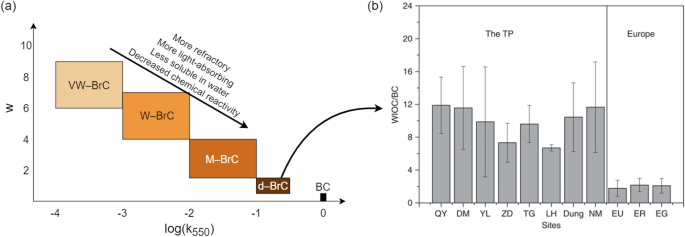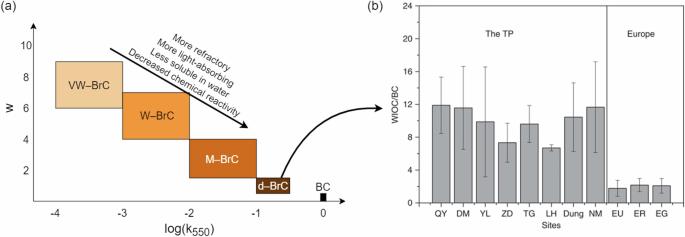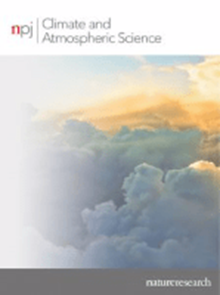野火产生的深褐色碳:一种有效的雪地辐射强迫因子?
IF 8.4
1区 地球科学
Q1 METEOROLOGY & ATMOSPHERIC SCIENCES
引用次数: 0
摘要
野火烟雾沉积在雪地上会导致雪地变黑并加速融雪。最近的实地研究发现,深棕色碳(d-BrC)占野火烟雾中短波吸收量的 50-75%。d-BrC 是一类独特的水不溶性光吸收有机碳,在世界各地的雪地中与黑碳(BC)大量共存。然而,与黑碳相比,d-BrC 作为雪地增温剂的重要性仍有待探索。我们利用实验室和实地测量数据集进行气溶胶-雪辐射传递计算,填补了这一空白。我们发现,d-BrC 会增加年均雪地辐射强迫 0.6 到 17.9 W m-2,与不同的野火烟雾沉积情景相对应。与纯 BC 沉积在雪地上相比,增加了 1.6 到 2.1 倍。这项研究表明,d-BrC 是造成中纬度冰川融雪的一个重要因素,全球约有 40% 的冰川表面积位于中纬度地区。本文章由计算机程序翻译,如有差异,请以英文原文为准。


Dark brown carbon from wildfires: a potent snow radiative forcing agent?
Deposition of wildfire smoke on snow contributes to its darkening and accelerated snowmelt. Recent field studies have identified dark brown carbon (d-BrC) to contribute 50–75% of shortwave absorption in wildfire smoke. d-BrC is a distinct class of water-insoluble, light-absorbing organic carbon that co-exists in abundance with black carbon (BC) in snow across the world. However, the importance of d-BrC as a snow warming agent relative to BC remains unexplored. We address this gap using aerosol-snow radiative transfer calculations on datasets from laboratory and field measurement. We show d-BrC increases the annual mean snow radiative forcing between 0.6 and 17.9 W m−2, corresponding to different wildfire smoke deposition scenarios. This is a 1.6 to 2.1-fold enhancement when compared with BC-only deposition on snow. This study suggests d-BrC is an important contributor to snowmelt in midlatitude glaciers, where ~40% of the world’s glacier surface area resides.
求助全文
通过发布文献求助,成功后即可免费获取论文全文。
去求助
来源期刊

npj Climate and Atmospheric Science
Earth and Planetary Sciences-Atmospheric Science
CiteScore
8.80
自引率
3.30%
发文量
87
审稿时长
21 weeks
期刊介绍:
npj Climate and Atmospheric Science is an open-access journal encompassing the relevant physical, chemical, and biological aspects of atmospheric and climate science. The journal places particular emphasis on regional studies that unveil new insights into specific localities, including examinations of local atmospheric composition, such as aerosols.
The range of topics covered by the journal includes climate dynamics, climate variability, weather and climate prediction, climate change, ocean dynamics, weather extremes, air pollution, atmospheric chemistry (including aerosols), the hydrological cycle, and atmosphere–ocean and atmosphere–land interactions. The journal welcomes studies employing a diverse array of methods, including numerical and statistical modeling, the development and application of in situ observational techniques, remote sensing, and the development or evaluation of new reanalyses.
 求助内容:
求助内容: 应助结果提醒方式:
应助结果提醒方式:


